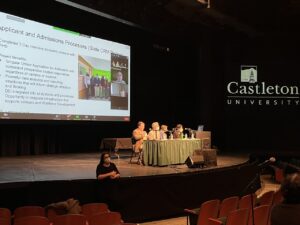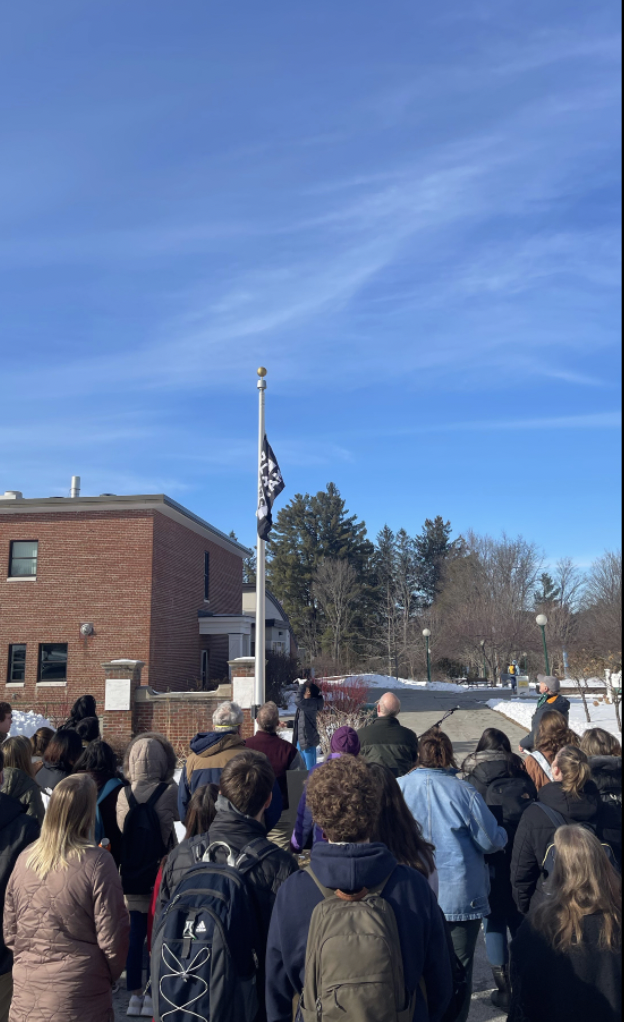‘Digital First’ or students first?

Castleton University community members filled the rows of Casella Theater to share their opinions once again on the progression of the rapidly approaching Vermont State University merger at the college’s second Transformation Town Hall meeting held on Feb. 9.
A panel of transformation leaders including Chancellor Sophie Zdatny, Castleton University interim President Thomas Mauhs-Pugh, Chief Academic Officer Yasmine Ziesler, and Castleton University Dean of Enrollment Maurice Ouimet, gathered to share recent progress and listen to feedback from those in attendance.
Discussions ranged from headway made in the new “Connections” General Education program with the drafting of a vision statement and mission, to questions regarding the future logo of the new university, and to a major point of contention at the meeting – the new “Digital First” transformation outlook.
“The goal (with the Digital First approach) is to use the technology that we have to really support the relationship-based education and transformative learning experiences that we have within the VSC,” Zdatny said to the crowd. “This is going to include not just academics, but the student support side as well. And it’s important to remember that digital first does not mean digital only.”
The platform intends to utilize Slate, a student-engagement software program that allows communication with student services outside of typical business hours, alongside a new initiative called “Face-to-Face Plus” to allow for broader and experimental ways of teaching and overseeing student success virtually.
“[An example of] face-to-face components of courses might be really intensive, laboratory kinds of experiences combined with more flexible ways of working through other parts of the course content,” Ziesler said. “Face-to-Face Plus is meant to encompass and invite us to experiment a little bit. What could that look like? What’s appropriate in different disciplines?”
But community members in attendance were certainly not as enthused about the prospect as panel members.
“You keep saying, ‘digital first, digital first.’ My thought, and I’ve heard it from a couple faculty who are sitting near me, is it should be student first. In previous transformation meetings and the Town Hall, you guys kept saying, ‘Student first, student first. This is for the students.’ Yet all I see is digital, digital, digital,” senior Tobias Duke said.
And though Ouimet followed, clarifying the Digital First method will be considerate of all students’ needs, criticism of the proposal was prevalent throughout the meeting.
Castleton professor Helen Mango said the Digital First title for the platform is misleading and makes it seem as though it is focused on entirely online education.
Lisa Pleban, a physical education professor, questioned the impact of virtual learning on student health and urged transformation leaders to look at students “as a whole person, and not just a client or customer.”
Rich Clark, a political science professor, argued that the hybrid modality will mean some students must take online classes due to the reduction in resources, whether they choose to or not.
But panel members responded by asking the disgruntled community members to consider how the experiences of non-traditional students fit within the proposed hybrid teaching modalities.
“Those of you who live on campus, it’s relatively easy to access those services because you live on campus. That’s a portion of our students. We also have a portion of our students, that President Mauhs-Pugh mentioned, that aren’t visible here,” Ouimet said. “A hybrid university means there’s something for everyone.”
Community members in attendance also applauded the presentation of results from a school-wide survey conducted by Student Government Association last Fall.
SGA President Ryan Boeke relayed the information gathered on questions including students’ overall awareness of the merger, their thoughts on the merger, and their learning preference.
In terms of awareness, Boeke said that 13.5% of students reported that they completely understand the merger, another 43.7% somewhat understand, and 42.8% barely understand or don’t understand at all.
Student responses regarding their thoughts on the merger reflected that 41.7% “either were for the merger, weren’t sure how to feel, or could be swayed but needed more information,” as Boeke said. The other 58.3% were completely against the merger.
The final question relating to student learning preferences reported that 28.8% wanted synchronous, asynchronous, or a mix of the two for class delivery. Those that wanted only an in-person experience reflected 71.4% of students surveyed.
Another point of contention between the panel and audience members revolved around the long-expected logo for the new university – which has yet to have been seen by the greater public or by transformation leaders.
“(The logo) would be a Vermont State University logo. But the logo that (marketing) is looking at, and I haven’t seen the final one, is a flexible logo where you can capture different elements. So, it could be a particular program, it could be a particular location. It’s going to provide flexibility so that there could be distinctiveness around it,” Zdatny said.
Community members expressed anxiety about how the logo, along with impending mascot and color decisions, might impact athletics at the school – which are already in jeopardy of facing cuts.
Ouimet expressed that an official logo will be released in the coming weeks, along with more decisions on how athletics will continue at the new university.
“There’s a guarantee that if a new one size fits all logo is just dropped on everybody in March, that it will not go over well,” Mango said.
After an hour-and-a-half of debate and a myriad of questions still in the air, Mauhs-Pugh thanked those in attendance and said by early May many answers should begin emerging.
“There are a lot of really important things that we need to know, and it is incredibly frustrating and very anxiety inducing not to have the answers to those questions,” he said. “Keep asking the questions, keep making the comments, (and) keep holding us accountable.”








